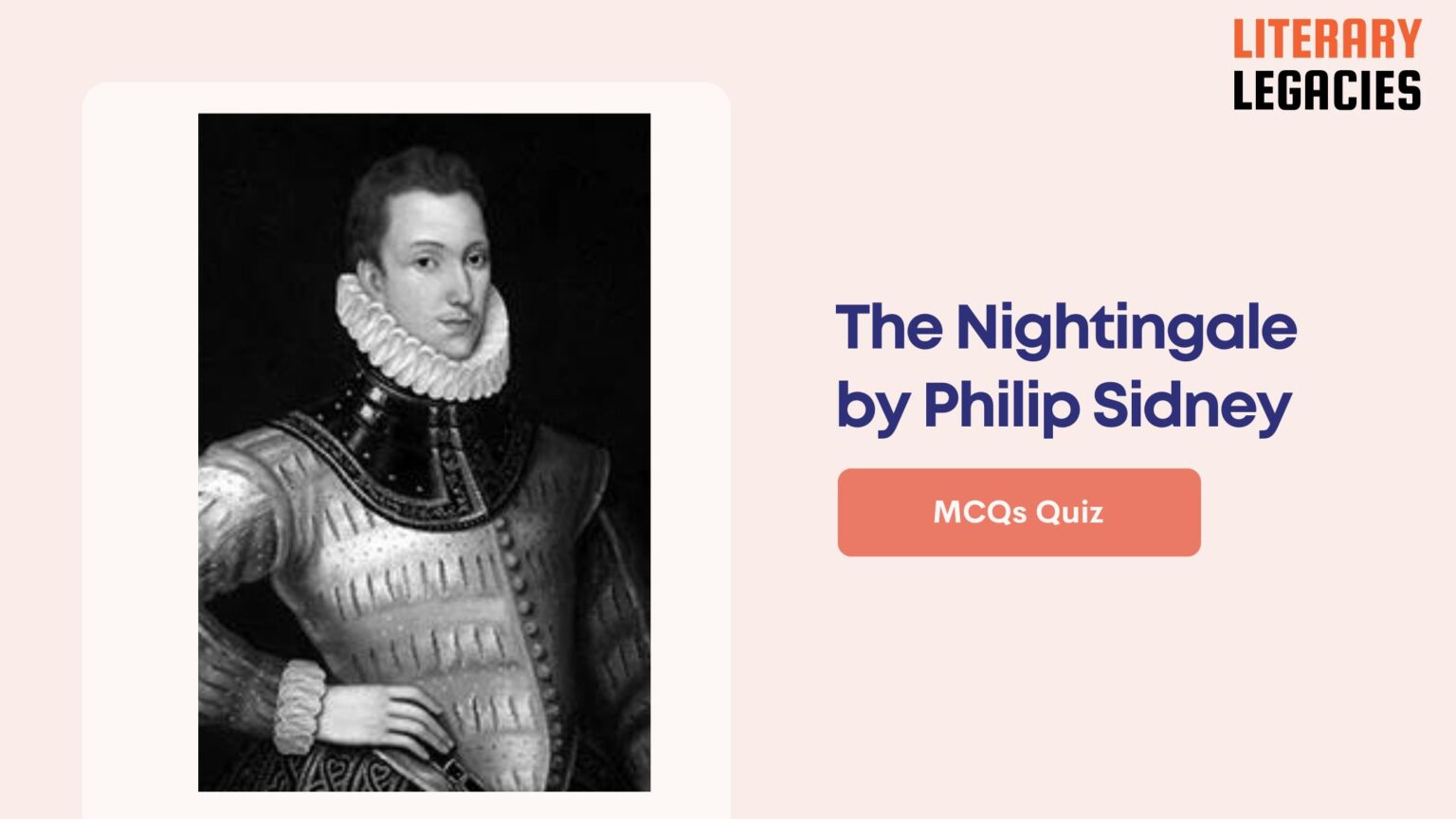1. What transformation do the characters undergo at the end of the poem?
A. They become birds
B. They are turned into flowers
C. They are transformed into clouds
D. They turn into trees
Answer: They become birds (A)
The story ends with Procne becoming a swallow, Philomela a nightingale, and Tereus a hoopoe.
2. What does the nightingale’s song symbolize in Sidney’s poem?
A. Joy and happiness
B. Nature’s beauty
C. The ability to express pain
D. Silence and oppression
Answer: The ability to express pain (C)
The nightingale’s song serves as a means for Philomela to articulate her pain over her trauma.
3. In the poem, what role does weaving a tapestry play in Philomela’s story?
A. A means of communication
B. A form of punishment
C. An act of rebellion
D. A way to decorate her home
Answer: A means of communication (A)
Philomela weaves her story into a tapestry to communicate her experience after being silenced.
4. What is significant about the nightingale’s song in the context of spring?
A. It is a warning of danger
B. It signifies rebirth and renewal
C. It represents the arrival of winter
D. It reflects the nightingale’s joy
Answer: It signifies rebirth and renewal (B)
The song contrasts the beauty of spring with Philomela’s sorrow, linking her pain to the season’s themes of rebirth.
5. How does the speaker’s experience differ from that of the nightingale?
A. He can express his feelings through song
B. He experiences joy instead of sadness
C. He must internalize his pain
D. He has transformed like the others
Answer: He must internalize his pain (C)
The speaker highlights that while the nightingale externalizes her pain, he must keep his feelings inside.
6. Which character is responsible for Philomela’s suffering?
A. The gods
B. A nightingale
C. Procne
D. Tereus
Answer: Tereus (D)
Tereus, Procne’s husband, is the one who assaults Philomela, leading to her transformation.
7. What does the phrase ‘proud new clothing of spring blossoms’ suggest about the changing season?
A. It symbolizes the nightingale’s song
B. It represents death and decay
C. It indicates the end of winter
D. It hints at an impending storm
Answer: It indicates the end of winter (C)
This phrase indicates the beauty and renewal that comes with spring as nature awakens.
8. Why does the speaker tell Philomela to ‘Take some gladness’?
A. To encourage her to sing more loudly
B. To persuade her to forget her pain
C. To downplay her suffering
D. To highlight their differing experiences
Answer: To highlight their differing experiences (D)
The speaker contrasts their experiences of mourning, encouraging Philomela to see some positivity amid her sorrow.
9. What characteristic of female nightingales is highlighted in Sidney’s poem?
A. They do not sing
B. They migrate during winter
C. They are colorful birds
D. They have a beautiful song
Answer: They do not sing (A)
It is noted that female nightingales typically do not sing, contrasting Philomela’s lamentation.
10. What is the primary reason for Philomela’s sadness in stanza 2?
A. She is unable to sing like the nightingale.
B. She longs for spring and the return of beauty.
C. She feels disconnected from nature.
D. She has been overpowered and raped by Tereus.
Answer: She has been overpowered and raped by Tereus. (D)
Philomela’s sadness is directly linked to her experience of being raped by Tereus.
11. How does the speaker characterize his own complaints in comparison to Philomela’s?
A. His complaints revolve around societal expectations.
B. He expresses them more vividly than she does.
C. His complaints are more superficial.
D. He believes they are more justified due to unfulfilled desires.
Answer: He believes they are more justified due to unfulfilled desires. (D)
The speaker feels that his feelings of longing are a deeper cause for lamentation than Philomela’s circumstances.
12. Which aspect of the poem’s structure mirrors the nightingale’s song?
A. A noticeable shift in tone throughout the poem.
B. A regular iambic pentameter in the first lines.
C. An irregular rhyme scheme.
D. A consistent thematic focus on sorrow.
Answer: A regular iambic pentameter in the first lines. (B)
The first four lines feature a mostly regular iambic pentameter, reflecting the beauty of the nightingale’s song.
13. What does the poet compare Philomela’s experience to in stanza 2?
A. The beauty of springtime.
B. The pain of isolation.
C. The joy of creative expression.
D. The speaker’s own romantic struggles.
Answer: The speaker’s own romantic struggles. (D)
The speaker compares Philomela’s plight to his own, reflecting his unfulfilled romantic longings.
14. What literary technique is used by the speaker to directly address Philomela?
A. Apostrophe.
B. Metaphor.
C. Alliteration.
D. Personification.
Answer: Apostrophe. (A)
The speaker employs apostrophe to directly engage with Philomela in the poem.
15. What does the phrase ‘thorn’ refer to in the context of Philomela’s song?
A. A symbol of spring.
B. Her enjoyment of melody.
C. An expression of hope.
D. Her suffering and pain.
Answer: Her suffering and pain. (D)
The ‘thorn’ signifies Philomela’s pain, transformed into a songbook of sorrow.
16. What notable change occurs in the rhyme scheme from the first stanza to the second stanza?
A. It transforms into a free verse style.
B. It becomes entirely consistent.
C. It shifts from ABAB to BAAB.
D. It remains constant throughout.
Answer: It shifts from ABAB to BAAB. (C)
The rhyme scheme changes from ABAB in the first stanza to BAAB in the second stanza.
17. What does the speaker suggest about the condition of Philomela compared to his own?
A. Philomela’s pain is minimal compared to his longing.
B. Philomela is oblivious to her suffering.
C. Philomela is better at expressing grief.
D. Philomela has more reasons to be joyful.
Answer: Philomela’s pain is minimal compared to his longing. (A)
The speaker implies that Philomela has less cause for lamentation than he does due to his deeper longing.
18. How is the transition between the depiction of beauty and sorrow represented in the poem?
A. Via the absence of natural elements.
B. With a consistent tone throughout.
C. By contrasting different poetic forms.
D. Through vivid imagery of destruction.
Answer: By contrasting different poetic forms. (C)
The transition is marked by a break from the regular beauty reflected in the poem’s structure and thematics.
19. What broader theme does the speaker’s comparison of their experiences highlight?
A. The contrasting experiences of joy and grief.
B. The complexity of creative expression.
C. The superiority of male pain over female pain.
D. The inevitability of suffering in life.
Answer: The contrasting experiences of joy and grief. (A)
The speaker’s reflections underline the complex relationship between joy and grief in both their lives.
20. What variation is present in the second stanza that distinguishes it from the first stanza?
A. It features more complex rhyme schemes.
B. It has a different number of lines.
C. It utilizes a consistent meter throughout.
D. It places greater focus on the speaker’s emotions.
Answer: It places greater focus on the speaker’s emotions. (D)
The second stanza emphasizes the speaker’s internal feelings more than the first stanza.
21. How does the speaker characterize Philomela’s response to her suffering?
A. As ‘womanlike’, suggesting a weaker disposition.
B. As noble and dignified despite her pain.
C. As manly and resilient in spirit.
D. As excessively dramatic and overblown.
Answer: As ‘womanlike’, suggesting a weaker disposition. (A)
The speaker implies that Philomela’s reaction to her suffering is ‘womanlike’ in a disparaging sense.
22. What rhythmic change occurs between lines 17-20 and the earlier lines?
A. They adopt a strict iambic pentameter.
B. They shift to a more consistent tetrameter.
C. They utilize a free verse style.
D. They return to the same meter as lines 3-8.
Answer: They return to the same meter as lines 3-8. (D)
The lines return to the meter found in lines 3-8, signifying a pass through different emotional states.
23. What does the speaker’s comparison of his desires to Philomela’s experience suggest?
A. He views sexual desire as acceptable, unlike her situation.
B. His pain is far graver than hers.
C. He is empathetic towards her suffering.
D. He feels he deserves love more than she does.
Answer: His pain is far graver than hers. (B)
The speaker argues that his unfulfilled desires make his suffering worse than Philomela’s trauma.
24. What effect does the repetition of lines 21-24 have on the poem?
A. It emphasizes the speaker’s hypocritical nature.
B. It highlights the speaker’s inability to forgive himself.
C. It shifts the focus to the external environment.
D. It serves as a transition to a new theme.
Answer: It emphasizes the speaker’s hypocritical nature. (A)
The repetition underscores the speaker’s hypocrisy and the seeming incongruity in his claims.
25. What tone does the speaker adopt when discussing his own suffering compared to Philomela’s?
A. A tone of resignation and acceptance.
B. A tone of deep admiration for Philomela.
C. A tone of indifference and apathy.
D. A tone of condescension and superiority.
Answer: A tone of condescension and superiority. (D)
The speaker’s tone suggests he believes his pain surpasses Philomela’s, reflecting a dismissive attitude.
26. How is the theme of song represented in the poem?
A. As irrelevant to the overall message.
B. As a joyous and uplifting occurrence.
C. As an expression of the speaker’s suffering.
D. As an element that diminishes Philomela’s story.
Answer: As an expression of the speaker’s suffering. (C)
The speaker equates his poetic expression with song, linking it to his own experience of sorrow.
27. What does the phrase ‘a kind of song, complete with a refrain’ imply about the speaker’s expression?
A. It reflects his struggle to articulate pain.
B. It lacks emotional depth and sincerity.
C. It is an imitation of Philomela’s narrative.
D. It follows a traditional and structured format.
Answer: It reflects his struggle to articulate pain. (A)
This phrase indicates that the speaker is wrestling with his emotions and the difficulty of conveying them.
28. What aspect of the stanza structure is emphasized through the variations in rhyme schemes?
A. The emotional discord experienced by the speaker.
B. The balance between grief and hope in the poem.
C. The contrast between natural and artistic expressions.
D. The distinction between the speaker and Philomela.
Answer: The emotional discord experienced by the speaker. (A)
The variations in rhyme highlight the speaker’s internal discord and emotional complexity.



